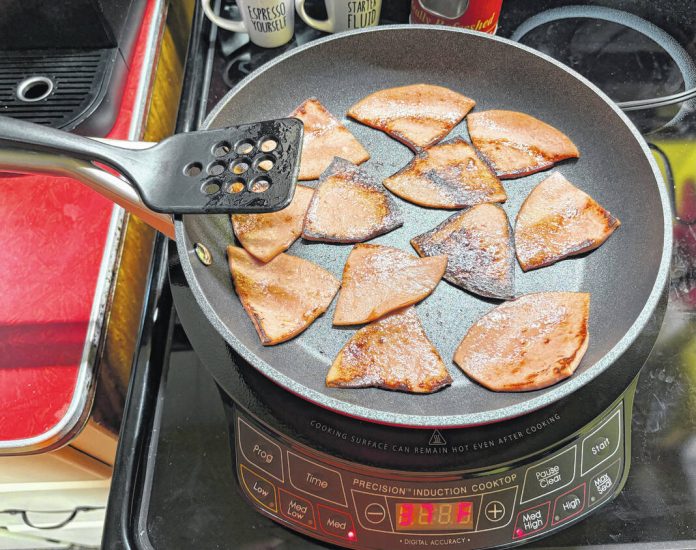While I was without a stove, I not only got to know my microwave oven a little better, but also I spent some time learning about my Nuwave Precision Induction Cooktop.
I had no idea what it was, how it worked, how to use it or what to cook on it.
My brain doesn’t always work like it used to, and I often struggle with being slow to learn (and do) multi-step processes that are new to me. But I still like a challenge and hope I always will. It’s fun (and satisfying) to do — and sometimes do well — what I fear I can’t (or shouldn’t) do.
An induction cooktop uses an electromagnetic field to heat food. It took me a minute to get used to the idea of needing a special pan to use on it (“induction safe” should be stamped on the bottom of the pan). But once I became familiar with the induction skillets and spatulas, I found that it was quick and easy to use.
Using the high, medium and low heat settings is a little different on an induction cooktop. If you have access to a computer, it’s easy to find details such as how many degrees equals “medium” or “medium high” on your cooktop. There are even suggestions for what types of food you might cook at those temperatures: Low, at 100-200 degrees, is good for melting chocolate. Good to know.
I wanted to fry some bologna and fix scrambled eggs, so I figured whatever was equal to medium heat on the stovetop would be a good place to start. I discovered that medium heat (200-300 degrees) is more suitable for simmering soups; I probably wanted a medium-high setting of 300-400 degrees, which is appropriate for frying meat (and sautéing veggies). High heat is 400-500 degrees, and what you want for boiling water or stir-frying.
I always had to wait several minutes for my stovetop burner to warm up before any food or sauces started heating. The induction cooktop heats up much more quickly (some would say instantly) and also responds more quickly when you change the temperature. It’s not difficult to understand why people like them and want to use them daily.
In the middle of frying my bologna, I debated my vegetable options. I have tried to create a habit of including some kind of vegetable (and fruit) with my meals. Believe it or not, asparagus makes a good accompaniment to fried bologna and eggs. I also cut a fresh tomato and cucumber. And voila, a simple yet satisfying meal is ready to eat.
Eggs and Bologna on the Induction Cooktop
Ingredients:
• 4 eggs
• 3 slices of thick bologna, cut into quarter pieces
• Splash of milk
Optional side dishes:
• 15 oz asparagus spears (drained)
• 1 large tomato
• 1 cucumber
• A slice of any kind of bread for toast
• Butter for toast
Slice the tomato and cucumber and set out on a plate.
Cut each slice of bologna into four pieces and place the pieces into the frying pan. Set the pan on the induction cooktop and set the degrees to 350. Fry the bologna pieces, turning every few minutes, until they’re crispy in spots. Put a paper towel on a plate and set the fried bologna pieces on it. In a bowl, crack 4 eggs, add a splash of milk and salt and pepper to taste and whisk until beaten. Pour into the same skillet where you fried your bologna. Stir and flip until thick and fluffy. Remove from pan, turn the induction cooktop off.
Asparagus can be heated in the microwave or fried with a dab of olive oil and salt and pepper to taste in a smaller skillet on the induction cooktop (again, roughly 350 degrees, give or take).
Want to share a meal with The Lima News readers? Send your recipe with your name, city of residence, phone number (won’t be published) and a photo of your meal to [email protected].







